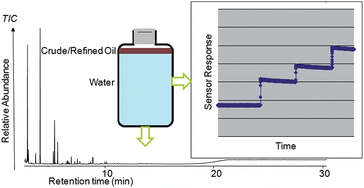This paper presents a system and method developed to identify a source oil's characteristic properties by testing the oil's dissolved components in water. Through close examination of the oil dissolution process in water, we hypothesise that when oil is in contact with water, the resulting oil–water extract, a complex hydrocarbon mixture, carries the signature property information of the parent oil. If the dominating differences in compositions between such extracts of different oils can be identified, this information could guide the selection of various sensors, capable of capturing such chemical variations. When used as an array, such a sensor system can be used to determine parent oil information from the oil–water extract. To test this hypothesis, 22 oils' water extracts were prepared and selected dominant hydrocarbons analyzed with Gas Chromatography-Mass Spectrometry (GC-MS); the subsequent Principal Component Analysis (PCA) indicates that the major difference between the extract solutions is the relative concentration between the volatile mono-aromatics and fluorescent polyaromatics. An integrated sensor array system that is composed of 3 volatile hydrocarbon sensors and 2 polyaromatic hydrocarbon sensors was built accordingly to capture the major and subtle differences of these extracts. It was tested by exposure to a total of 110 water extract solutions diluted from the 22 extracts. The sensor response data collected from the testing were processed with two multivariate analysis tools to reveal information retained in the response patterns of the arrayed sensors: by conducting PCA, we were able to demonstrate the ability to qualitatively identify and distinguish different oil samples from their sensor array response patterns. When a supervised PCA, Linear Discriminate Analysis (LDA), was applied, even quantitative classification can be achieved: the multivariate model generated from the LDA achieved 89.7% of successful classification of the type of the oil samples. By grouping the samples based on the level of viscosity and density we were able to reveal the correlation between the oil extracts' sensor array responses and their original oils' feature properties. The equipment and method developed in this study have promising potential to be readily applied in field studies and marine surveys for oil exploration or oil spill monitoring.

You have access to this article
 Please wait while we load your content...
Something went wrong. Try again?
Please wait while we load your content...
Something went wrong. Try again?


 Please wait while we load your content...
Please wait while we load your content...